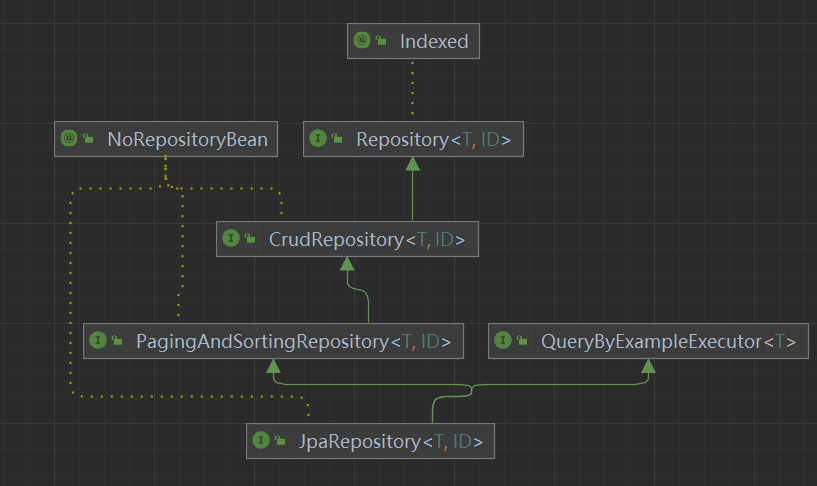Appearance
Repository
Spring Data Jpa为开发者提供了一些类的Repository接口,他们的集成关系图下图所示

- Repository是一个空接口,只具有标记作用;CrudRepository接口定义基本的CRUD操作;PagingAndSortingRepository接口定义分页和排序查询;QueryByExampleExecutor接口简单的动态查询方法;JpaRepository则是以上接口的子接口,集成他们的所有操作,并提供其常见操作,是使用Spring Data Jpa自定义持久层接口时常见的直接继承接口
JpaRepository规范的方法:
/*
* Copyright 2008-2021 the original author or authors.
*
* Licensed under the Apache License, Version 2.0 (the "License");
* you may not use this file except in compliance with the License.
* You may obtain a copy of the License at
*
* https://www.apache.org/licenses/LICENSE-2.0
*
* Unless required by applicable law or agreed to in writing, software
* distributed under the License is distributed on an "AS IS" BASIS,
* WITHOUT WARRANTIES OR CONDITIONS OF ANY KIND, either express or implied.
* See the License for the specific language governing permissions and
* limitations under the License.
*/
package org.springframework.data.jpa.repository;
import java.util.List;
import javax.persistence.EntityManager;
import org.springframework.data.domain.Example;
import org.springframework.data.domain.Sort;
import org.springframework.data.repository.NoRepositoryBean;
import org.springframework.data.repository.PagingAndSortingRepository;
import org.springframework.data.repository.query.QueryByExampleExecutor;
/**
* JPA specific extension of {@link org.springframework.data.repository.Repository}.
*
* @author Oliver Gierke
* @author Christoph Strobl
* @author Mark Paluch
* @author Sander Krabbenborg
* @author Jesse Wouters
*/
@NoRepositoryBean
public interface JpaRepository<T, ID> extends PagingAndSortingRepository<T, ID>, QueryByExampleExecutor<T> {
/*
* (non-Javadoc)
* @see org.springframework.data.repository.CrudRepository#findAll()
*/
@Override
List<T> findAll();
/*
* (non-Javadoc)
* @see org.springframework.data.repository.PagingAndSortingRepository#findAll(org.springframework.data.domain.Sort)
*/
@Override
List<T> findAll(Sort sort);
/*
* (non-Javadoc)
* @see org.springframework.data.repository.CrudRepository#findAll(java.lang.Iterable)
*/
@Override
List<T> findAllById(Iterable<ID> ids);
/*
* (non-Javadoc)
* @see org.springframework.data.repository.CrudRepository#save(java.lang.Iterable)
*/
@Override
<S extends T> List<S> saveAll(Iterable<S> entities);
/**
* Flushes all pending changes to the database.
*/
void flush();
/**
* Saves an entity and flushes changes instantly.
*
* @param entity entity to be saved. Must not be {@literal null}.
* @return the saved entity
*/
<S extends T> S saveAndFlush(S entity);
/**
* Saves all entities and flushes changes instantly.
*
* @param entities entities to be saved. Must not be {@literal null}.
* @return the saved entities
* @since 2.5
*/
<S extends T> List<S> saveAllAndFlush(Iterable<S> entities);
/**
* Deletes the given entities in a batch which means it will create a single query. This kind of operation leaves JPAs
* first level cache and the database out of sync. Consider flushing the {@link EntityManager} before calling this
* method.
*
* @param entities entities to be deleted. Must not be {@literal null}.
* @deprecated Use {@link #deleteAllInBatch(Iterable)} instead.
*/
@Deprecated
default void deleteInBatch(Iterable<T> entities){deleteAllInBatch(entities);}
/**
* Deletes the given entities in a batch which means it will create a single query. This kind of operation leaves JPAs
* first level cache and the database out of sync. Consider flushing the {@link EntityManager} before calling this
* method.
*
* @param entities entities to be deleted. Must not be {@literal null}.
* @since 2.5
*/
void deleteAllInBatch(Iterable<T> entities);
/**
* Deletes the entities identified by the given ids using a single query. This kind of operation leaves JPAs first
* level cache and the database out of sync. Consider flushing the {@link EntityManager} before calling this method.
*
* @param ids the ids of the entities to be deleted. Must not be {@literal null}.
* @since 2.5
*/
void deleteAllByIdInBatch(Iterable<ID> ids);
/**
* Deletes all entities in a batch call.
*/
void deleteAllInBatch();
/**
* Returns a reference to the entity with the given identifier. Depending on how the JPA persistence provider is
* implemented this is very likely to always return an instance and throw an
* {@link javax.persistence.EntityNotFoundException} on first access. Some of them will reject invalid identifiers
* immediately.
*
* @param id must not be {@literal null}.
* @return a reference to the entity with the given identifier.
* @see EntityManager#getReference(Class, Object) for details on when an exception is thrown.
* @deprecated use {@link JpaRepository#getById(ID)} instead.
*/
@Deprecated
T getOne(ID id);
/**
* Returns a reference to the entity with the given identifier. Depending on how the JPA persistence provider is
* implemented this is very likely to always return an instance and throw an
* {@link javax.persistence.EntityNotFoundException} on first access. Some of them will reject invalid identifiers
* immediately.
*
* @param id must not be {@literal null}.
* @return a reference to the entity with the given identifier.
* @see EntityManager#getReference(Class, Object) for details on when an exception is thrown.
* @since 2.5
*/
T getById(ID id);
/*
* (non-Javadoc)
* @see org.springframework.data.repository.query.QueryByExampleExecutor#findAll(org.springframework.data.domain.Example)
*/
@Override
<S extends T> List<S> findAll(Example<S> example);
/*
* (non-Javadoc)
* @see org.springframework.data.repository.query.QueryByExampleExecutor#findAll(org.springframework.data.domain.Example, org.springframework.data.domain.Sort)
*/
@Override
<S extends T> List<S> findAll(Example<S> example, Sort sort);
}